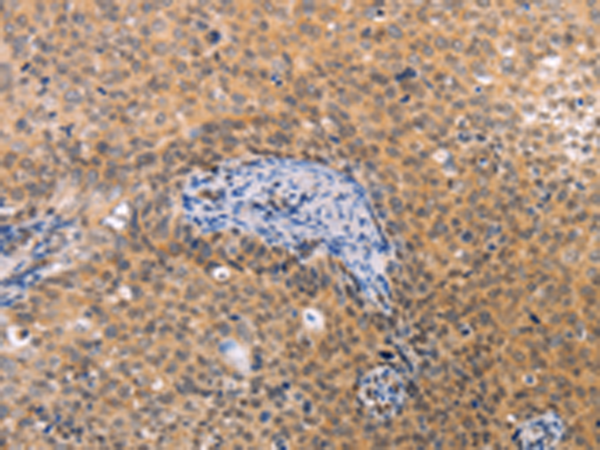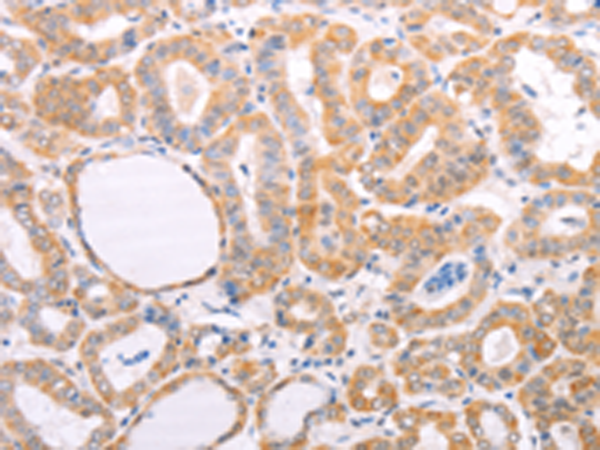

| WB | 咨询技术 | Human,Mouse,Rat |
| IF | 咨询技术 | Human,Mouse,Rat |
| IHC | 咨询技术 | Human,Mouse,Rat |
| ICC | 技术咨询 | Human,Mouse,Rat |
| FCM | 咨询技术 | Human,Mouse,Rat |
| Elisa | 咨询技术 | Human,Mouse,Rat |
| Aliases | RCA1; VHL1; pVHL; HRCA1 |
| Host/Isotype | Rabbit IgG |
| Antibody Type | Primary antibody |
| Storage | Store at 4°C short term. Aliquot and store at -20°C long term. Avoid freeze/thaw cycles. |
| Species Reactivity | Human |
| Immunogen | Fusion protein of human VHL |
| Formulation | Purified antibody in PBS with 0.05% sodium azide and 50% glycerol. |
+ +
以下是3篇与Tau蛋白Ser416位点磷酸化(Tau(pS416))抗体相关的文献概览:
---
1. **文献名称**: *Phosphorylation of microtubule-associated protein tau by stress-activated protein kinases*
**作者**: Goedert, M., et al.
**摘要**: 该研究首次报道了应激激活蛋白激酶(SAPKs)对Tau蛋白Ser416位点的磷酸化作用,证明该位点磷酸化影响Tau与微管的结合能力,并可能与神经退行性疾病中的微管稳定性失调相关。
2. **文献名称**: *Site-specific phosphorylation of tau accompanied by activation of mitogen-activated protein kinase (MAPK) in Alzheimer’s disease*
**作者**: Hasegawa, M., et al.
**摘要**: 通过Tau(pS416)抗体的免疫组化分析,发现阿尔茨海默病患者脑组织中Ser416位点的磷酸化水平显著升高,且与MAPK通路激活相关,提示该磷酸化可能促进神经纤维缠结的形成。
3. **文献名称**: *Phosphorylation of Serine 416 on Tau protein is a biochemical marker of early neurodegeneration*
**作者**: Luna-Muñoz, J., et al.
**摘要**: 利用Tau(pS416)特异性抗体,研究证明Tau的Ser416磷酸化在转基因小鼠模型中可作为早期神经元损伤的生物标志物,并与认知功能下降呈正相关。
4. **文献名称**: *Phospho-tau antibodies in Alzheimer’s disease: selective detection of pathological conformers*
**作者**: Jeganathan, S., et al.
**摘要**: 比较多种磷酸化Tau抗体的特异性,发现Tau(pS416)抗体能选择性识别阿尔茨海默病脑组织中的病理性Tau聚集体,为病理诊断提供了工具。
---
以上文献均聚焦于Tau蛋白Ser416位点磷酸化的生物学意义及其抗体在疾病机制研究中的应用。如需具体DOI或期刊信息,可进一步补充。
Tau (phospho-Ser416) antibody is a specialized tool used to study the phosphorylation state of tau protein at serine residue 416. a post-translational modification implicated in neurodegenerative diseases. Tau, a microtubule-associated protein predominantly expressed in neurons, stabilizes microtubules and supports axonal transport. Its function is regulated by phosphorylation, which modulates microtubule binding. However, hyperphosphorylation of tau at specific residues, including Ser416. is a hallmark of pathological aggregates called neurofibrillary tangles (NFTs), observed in Alzheimer’s disease (AD) and other tauopathies.
Phosphorylation at Ser416 is linked to conformational changes that reduce tau’s affinity for microtubules, promoting detachment and subsequent aggregation. This aberrant modification may also facilitate tau’s interaction with other proteins, exacerbating toxicity. The Tau (phospho-Ser416) antibody enables researchers to detect and quantify this phosphorylation event in experimental models, aiding studies on tau pathology mechanisms. It is widely used in techniques like Western blotting, immunohistochemistry, and immunofluorescence to assess disease progression, evaluate therapeutic interventions, or validate cellular models of tau dysfunction.
This antibody’ specificity for phospho-Ser416 makes it valuable for distinguishing pathological tau from normal isoforms, offering insights into early disease biomarkers and targeted treatment strategies. Its application spans basic research, drug discovery, and diagnostic development in neurodegenerative disorders.
×